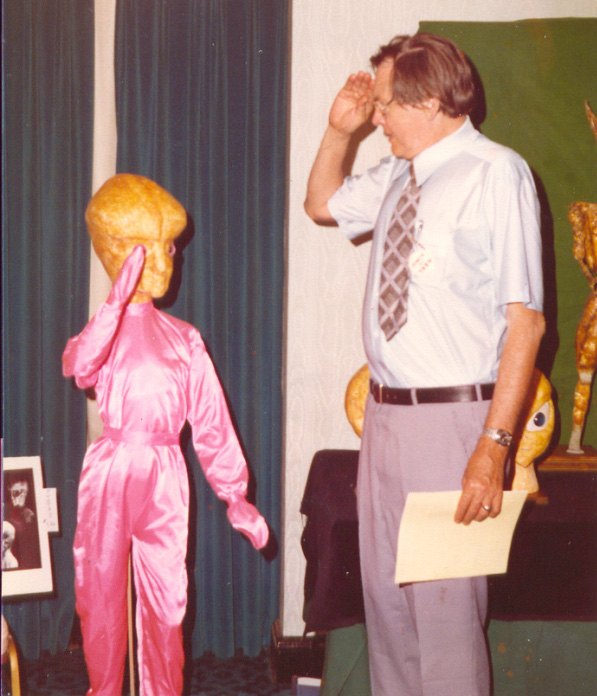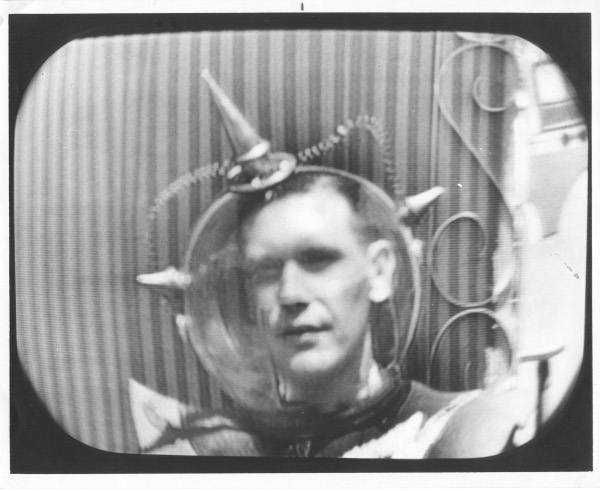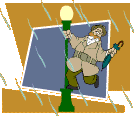
 Hello. Elston Gunn here.
If the name Gray Barker doesn’t ring a bell, his legacy most assuredly does. Barker was a writer from West Virginia who penned books, articles and essays about UFOs and the supernatural. His first book, THEY KNEW TOO MUCH ABOUT FLYING SAUCERS (1956), introduced the idea of the mysterious Men in Black and incited myths of the paranoid and the paranormal. Among his works, too, was an investigative book about the Mothman creature case, popularized later by writer John Keel (including a famous illustration by the late Frank Frazetta). Barker died in 1984 and left behind a legacy of the mysterious and mythological. Whether completely manufactured; embellished and disseminated; or simply investigated and reported, his work lives in everything from X-FILES to MEN IN BLACK to UFO fanzines.
Barker is the subject of filmmaker Bob Wilkinson’s documentary SHADES OF GRAY
Hello. Elston Gunn here.
If the name Gray Barker doesn’t ring a bell, his legacy most assuredly does. Barker was a writer from West Virginia who penned books, articles and essays about UFOs and the supernatural. His first book, THEY KNEW TOO MUCH ABOUT FLYING SAUCERS (1956), introduced the idea of the mysterious Men in Black and incited myths of the paranoid and the paranormal. Among his works, too, was an investigative book about the Mothman creature case, popularized later by writer John Keel (including a famous illustration by the late Frank Frazetta). Barker died in 1984 and left behind a legacy of the mysterious and mythological. Whether completely manufactured; embellished and disseminated; or simply investigated and reported, his work lives in everything from X-FILES to MEN IN BLACK to UFO fanzines.
Barker is the subject of filmmaker Bob Wilkinson’s documentary SHADES OF GRAY , which was released this week on DVD. The film is a fascinating look into the mind of a mythmaker and those who knew him, conspired with him and studied his work. You can visit the film’s official website at http://theyknewtoomuch.com/ or purchase the DVD here
, which was released this week on DVD. The film is a fascinating look into the mind of a mythmaker and those who knew him, conspired with him and studied his work. You can visit the film’s official website at http://theyknewtoomuch.com/ or purchase the DVD here .
Wilkinson took time to answer questions about Barker and the making of SHADES OF GRAY for AICN.
[Elston Gunn]: When did you first hear about Gray Barker and at what moment did you decide "Okay, I need to make a film about this guy"?
[Bob Wilkinson]: I ran across Barker in Jeanne Mozier's book WAY OUT IN WEST VIRGINIA. She wrote about a large collection of UFO material that was housed in the Clarksburg Library. At first glance, I thought it would make an interesting film, so I decided to make the trip up to Clarksburg. I spoke with the curator David Houchin and dug through the many files of stories, correspondence and photos and knew this would make a great film. After that visit, I set out solo and began to gather interviews about him.
[EG]: Was it the Flatwoods Monster article in FATE magazine that started it all for Barker? Did this come out of a lifelong love of horror films and fiction?
[BW]: That article began his role as a reporter. It was a story in his own backyard in West Virginia, so it gave him a springboard to get started. He was a horror and fiction fan, he looked up to Ray Palmer and the pulps he published, but I think he truly saw himself as a reporter during the investigations he conducted. He interviewed witnesses of not only the Flatwoods Monster but the Mothman case as well, he also interviewed Carlos Allende about the Philadelphia Experiment, so he had his hand in all the major events of that era.
[EG]: Why did John Keel's Mothman book receive more attention than Barker's, though it was published a few years later?
[BW]: Barker decided to self-publish his book, so I think that hurt him a bit. He had been publishing his Saucerian 'zine and other publications throughout the 50's and 60's the only exception being THEY KNEW TOO MUCH ABOUT FLYING SAUCERS. He also didn't get many of them printed up and they became quite rare until recently and were selling on eBay just a few years ago for $200. I've read both the Keel book and Barker's SILVER BRIDGE and I like Barker's book better. Keels book feels disjointed to me, Barker added a lot of color to his book and it's possibly his best work that he published.
[EG]: Could you talk a little about the saucerian movement for those who may not be familiar and Barker's role within it? How much of his involvement (and legacy) was a result of his own instigation versus being at the right place at the right time?
[BW]: I think he single-handedly did more to promote the idea of the Men in Black than any other writer in the UFO field. That will be his legacy, the Paranoid Theory. I believe he was out to discover the "Truth" and went after it with all of his passion, time and effort. Like many others, that truth was elusive but he stayed in the Field up until the time of his death. In his later years he began to have a bit more fun with the subject and not take it so seriously, but he was publishing books up till the end.
.
Wilkinson took time to answer questions about Barker and the making of SHADES OF GRAY for AICN.
[Elston Gunn]: When did you first hear about Gray Barker and at what moment did you decide "Okay, I need to make a film about this guy"?
[Bob Wilkinson]: I ran across Barker in Jeanne Mozier's book WAY OUT IN WEST VIRGINIA. She wrote about a large collection of UFO material that was housed in the Clarksburg Library. At first glance, I thought it would make an interesting film, so I decided to make the trip up to Clarksburg. I spoke with the curator David Houchin and dug through the many files of stories, correspondence and photos and knew this would make a great film. After that visit, I set out solo and began to gather interviews about him.
[EG]: Was it the Flatwoods Monster article in FATE magazine that started it all for Barker? Did this come out of a lifelong love of horror films and fiction?
[BW]: That article began his role as a reporter. It was a story in his own backyard in West Virginia, so it gave him a springboard to get started. He was a horror and fiction fan, he looked up to Ray Palmer and the pulps he published, but I think he truly saw himself as a reporter during the investigations he conducted. He interviewed witnesses of not only the Flatwoods Monster but the Mothman case as well, he also interviewed Carlos Allende about the Philadelphia Experiment, so he had his hand in all the major events of that era.
[EG]: Why did John Keel's Mothman book receive more attention than Barker's, though it was published a few years later?
[BW]: Barker decided to self-publish his book, so I think that hurt him a bit. He had been publishing his Saucerian 'zine and other publications throughout the 50's and 60's the only exception being THEY KNEW TOO MUCH ABOUT FLYING SAUCERS. He also didn't get many of them printed up and they became quite rare until recently and were selling on eBay just a few years ago for $200. I've read both the Keel book and Barker's SILVER BRIDGE and I like Barker's book better. Keels book feels disjointed to me, Barker added a lot of color to his book and it's possibly his best work that he published.
[EG]: Could you talk a little about the saucerian movement for those who may not be familiar and Barker's role within it? How much of his involvement (and legacy) was a result of his own instigation versus being at the right place at the right time?
[BW]: I think he single-handedly did more to promote the idea of the Men in Black than any other writer in the UFO field. That will be his legacy, the Paranoid Theory. I believe he was out to discover the "Truth" and went after it with all of his passion, time and effort. Like many others, that truth was elusive but he stayed in the Field up until the time of his death. In his later years he began to have a bit more fun with the subject and not take it so seriously, but he was publishing books up till the end.

[EG]: It seems like sending his book THEY KNEW TO MUCH ABOUT FLYING SAUCERS to University Press was a seminal moment for him, not the least of which was introducing the idea of "men in black."
[BW]: It was a very pivotal moment because it put him on the map. The success of the book made him an authority on the UFO culture, especially the cases involving the Men in Black.
[EG]: Do you think his passion was mythmaking and creating something that felt real and inspiring, whether it was or not? I love that someone in the film said he never gave away his personal opinion about anything, while someone else said he believed in everything. Do you think he enjoyed taking the piss out of people? The George Adamski prank is wonderful.
[BW]: I think he began to see himself as an entertainer and he gave the people what they wanted. He began catering to what is known as the "fringe" of ufology and he would seek out the wildest stories he could find. And these weren't something he was making up he would go out and gather the stories and write them up, he just didn't care if the individual was making them up or not. He would publish anything that was a good story.
[EG]: What's your favorite Gray Barker anecdote?
[BW]: Barker was a frequent guest on a popular radio show called THE LONG JOHN NEBEL SHOW. On the Nov. 16, 1958 show, Jackie Gleason called into the show and Barker tried to convince Gleason to buy tickets to fly in a genuine flying saucer. Gleason was supposed to be on the show for a ten-minute segment but, apparently, took exception to some of Barker's writings and ended up being on the show for the entire hour, going back and forth with Barker.
[EG]: How did you shoot and edit the film? What's the best advice would you give aspiring documentary filmmakers?
[BW]: I just used whatever I had to shoot with, and whatever gear I could scrounge up. The two main books I drew inspiration from was REBEL WITHOUT A CREW by Robert Rodriguez and HOW I MADE A HUNDRED MOVIES IN HOLLYWOOD AND NEVER LOST A DIME by Roger Corman. The theme of both of those books were go out and do it, don't let money or grants or negative people get in the way. I would tell aspiring filmmaker that if you have a story you want to tell then go out and do it. I did many a shoots on this film where I was the Camera Operator, the Sound Man, Gaffer and conducted the interview. It was hard work but I was driven to tell Barker's story and I didn't let anything get in the way. I would also tell them to go and buy the two books I mentioned, buy a decent camera and microphone and make it happen. Those are the only tools you need to begin.
[EG]: What was the biggest pragmatic lesson you learned in making SHADES OF GRAY?
[BW]: The best lesson I learned is you don't need the best equipment and a ton of money to tell a good story, and at the same time you don't have to compromise the quality of the film just because you don't have all the fancy gear. You just have to be creative and resourceful. I would have to say my biggest surprise was getting distribution for the film. If not for Jeff and Bob Tinnell believing in me, I don't know if the film would have made it outside of the state of West Virginia, so they were instrumental. When I see it on Blockbuster's website or Netflix, Walmart, Target, Amazon.com and on and on, I just sit there in disbelief at the whole thing.
[EG]: What are you working on next?
[BW]: I'm currently working on a project again with Jeff and Bob Tinnell of Allegheny Image Factory about Harry Powers. He was a serial killer in the early '30s and he became the inspiration for the film NIGHT OF THE HUNTER. The film explores the public and media's fascination with violence. The website is http://romeomusthang.com Check it out.
Elston Gunn
elstongunn@hotmail.com




